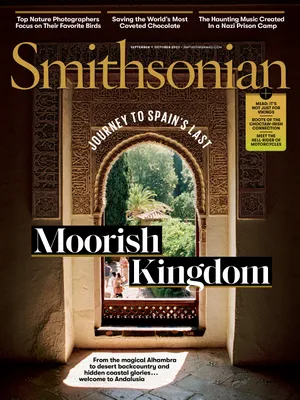Before Lady Liberty, There Was Lady Columbia, America’s First National Mascot
The forgotten figure symbolized the hopes—and myths—of the early United States
:focal(1050x750:1051x751)/https://tf-cmsv2-smithsonianmag-media.s3.amazonaws.com/filer_public/cd/4b/cd4bd968-a692-4c2e-a0e7-826ecfa917fc/lady.jpg)
The first and longest-ruling mascot of the United States made her debut before the country was even a country, appearing in 17th-century poems and sermons under the name “Columbina.” Samuel Sewall, a chief justice of the Province of Massachusetts Bay, captured her early ethos in a 1697 essay: She was, Sewall wrote, an emblem of the “New Heaven” of the American colonies.
By the early 18th century, she was known by the less diminutive “Columbia,” and she became ubiquitous in political cartoons, posters and newspapers. She was portrayed as a goddess, draped in a neoclassical gown and holding a sword, an olive branch and a laurel wreath as metaphors for justice, peace and victory. As Lady Columbia’s image spread across the country, particularly after the Revolution, she came to embody the nation’s highest aspirations—and its colonial ambitions. Though largely forgotten today, she reigned for two centuries as our collective emblem, and her biography offers a tale in miniature of the development of a young democracy.
As she guided colonial America, Lady Columbia served as a nurturing mother figure, but by the time of the Revolution, she was closer to an avenging angel. In 1775, during the first year of the war, the pioneering African American poet Phillis Wheatley sent General George Washington an ode to Columbia: “Columbia’s arm prevails … Proceed, great chief, with virtue on thy side, / Thy ev’ry action let the goddess guide.”
Throughout the Revolution, Columbia was a source of strength, a rallying cry. By the end of the war, the victorious colonists celebrated their triumph by invoking her: “Hail Columbia, happy land, / Hail, ye heroes, heav’n-born band, / Who fought and bled in Freedom’s cause,” the lawyer and poet Joseph Hopkinson wrote in 1798. Hopkinson’s verses were soon set to music, and “Hail Columbia” became the country’s first, if unofficial, national anthem, sung throughout the 19th century.
/https://tf-cmsv2-smithsonianmag-media.s3.amazonaws.com/filer_public/a0/d6/a0d6b27a-e3fb-4762-babe-4f60df2a8822/sepoct2023_c03_prologue.jpg)
When the War of 1812 began, Lady Columbia was sometimes joined on posters by a new figure, Uncle Sam; both offered a fierce embodiment of American independence. In the decades before the Civil War, both North and South invoked Columbia. In perhaps her most extraordinary appearance, Columbia showed off her strength as a disciplinarian: One 1860 cartoon depicts her spanking Stephen Douglas for having created a schism in the Democratic Party by proposing that laws about slavery should be left to individual states. “You have been a bad boy, Steve … and now I’ll pay you for it,” Columbia says as she swats Douglas.
By the 1870s, Columbia had become a symbol of Manifest Destiny, guiding the country’s westward expansion, says Michael D. Hattem, author of the 2020 book Past and Prologue: Politics and Memory in the American Revolution. This role prompted the most famous image of Lady Columbia, in John Gast’s 1872 painting American Progress.
One of Lady Columbia’s most poignant roles came in the next decade, as the country greeted swells of immigrants arriving from Europe—and Columbia helped hold the door open. “Columbia welcomes the victims of German persecution to ‘the asylum of the oppressed,’” reads the caption of a political cartoon published in 1881. Her image was used to help rally millions of immigrants toward an American identity—and, Hattem says, to reinforce a new patriotic movement called Columbianism.
As Columbianism swept the nation, in 1893 Lady Columbia gave her name and her likeness to posters for the World’s Columbian Exposition—that year’s world’s fair in Chicago. Yet the fair also helped spell Lady Columbia’s doom: At his keynote address, the historian Frederick Jackson Turner declared to the American Historical Association that the western frontier was now closed.
“Once there was no frontier left, [Lady Columbia] had, to an important degree, outlived her usefulness as a symbol” of westward expansion, Hattem says. At the same time, advocates like John Dewey were democratizing education, displacing a focus on Greek and Latin with a more modern—and therefore more American—focus on science and problem solving. Columbia, with her Greco-Roman vibe, no longer represented the nation’s educational philosophy.
Meanwhile, another female avatar for the nation was capturing the imaginations of millions of new immigrants from Italy, Poland and Russia: the Statue of Liberty, dedicated in New York Harbor in 1886. This new guardian became “a symbol for a land where the down-trodden and despised have found a chance,” as the New York Times wrote in 1903, the same year Emma Lazarus’ poem “The New Colossus” was cast on a bronze plaque in the base of the statue. With unchained shackles at her feet, the Statue of Liberty represented freedom at a time when “America is now the one shedding enlightenment on the rest of the world,” says Jeanne Gutierrez, a senior research fellow at the New-York Historical Society. And in World War I, the ruddy-faced, gruff-looking Uncle Sam came to supplant the more ethereal Columbia in war propaganda.
By 1931, when the “Star-Spangled Banner” was officially declared our national anthem, replacing “Hail Columbia,” Lady Columbia was all but gone. Yet her influence is still all around us. Visit Columbia University, and a seated Columbia greets you, arms aloft. At the National Memorial Cemetery of the Pacific in Honolulu, a grand Columbia statue honors mothers of fallen veterans. Her most frequent appearance these days, though, is in movie theaters, where she lives on as the logo for Columbia Pictures—a role in which she has shone for nearly a century, since 1924.
